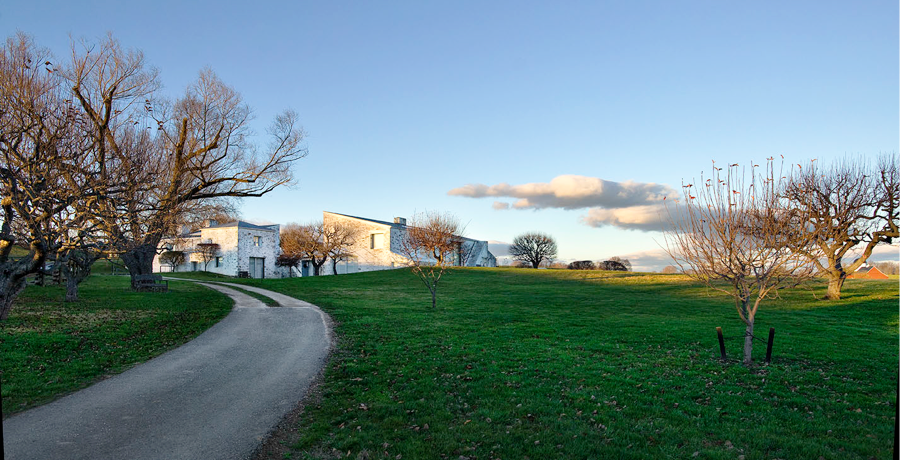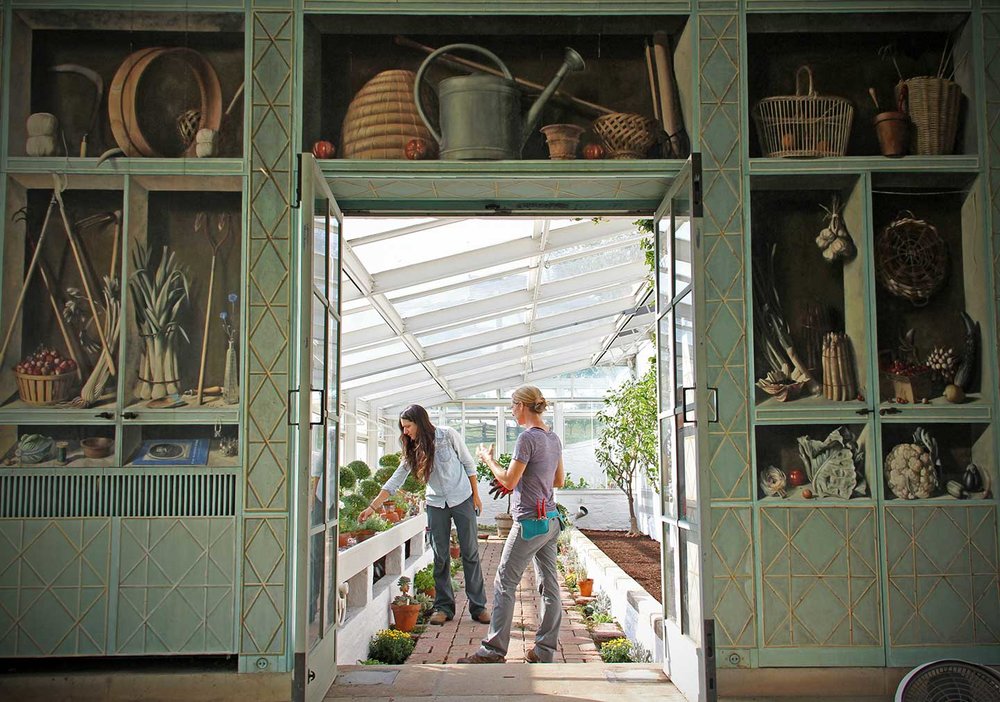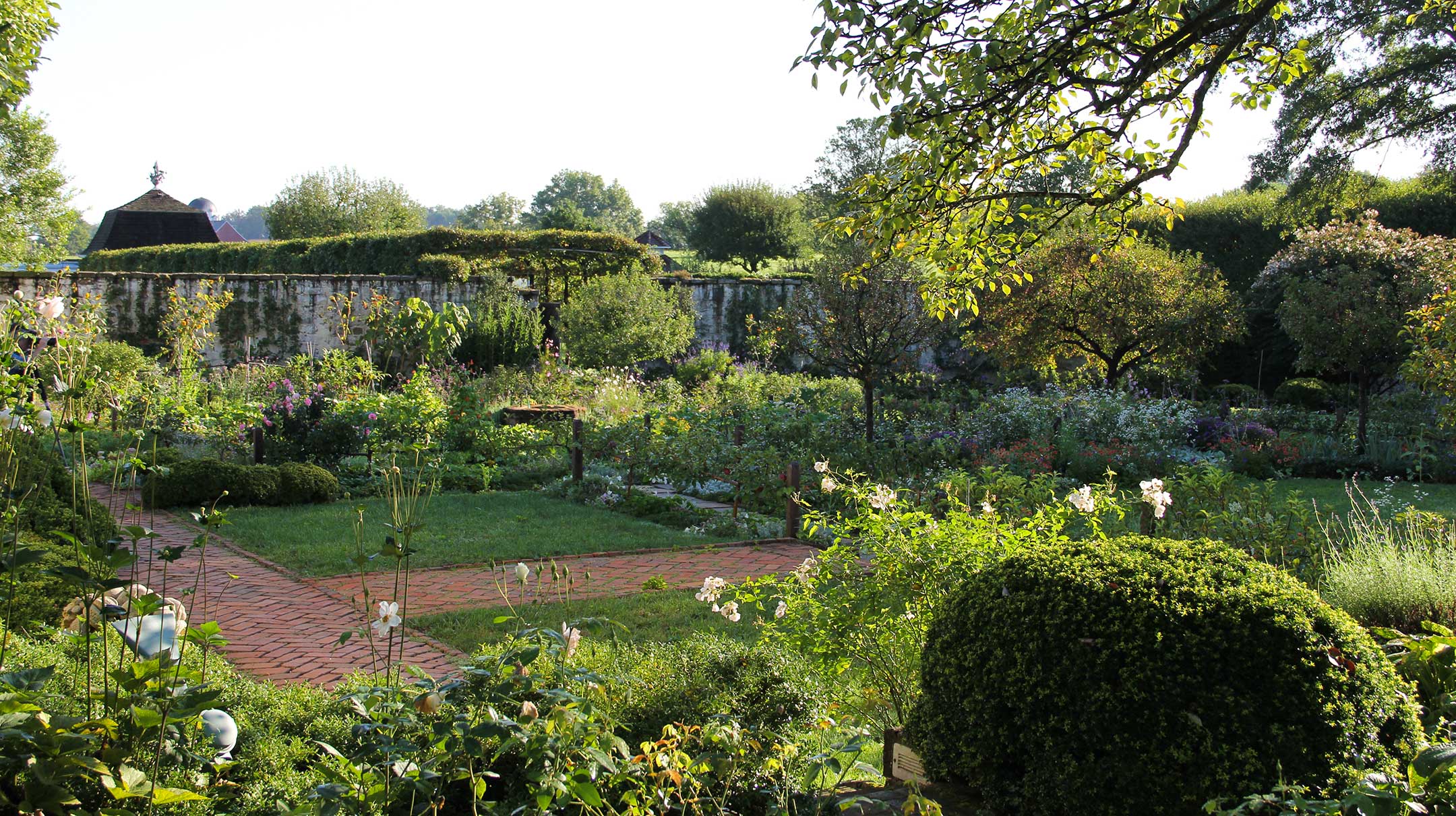Tending to One’s Own Library: The Origins and Outlooks of Bunny Mellon’s Oak Spring Garden Library
Spencer W. Stuart digs into the fertile collection of garden designer Bunny Mellon.
View of Oak Spring Garden Library. © Oak Spring Garden Foundation
"A library is built during a lifetime, it doesn’t happen overnight.” - Bunny Mellon
It has been nearly four years since the passing of Rachel “Bunny” Mellon (nee Lambert) and, as with most public figures of her stature, definitions of her life are being shaped and solidified. There is the public persona of Mellon as a philanthropist, socialite, and political influencer. She was also a private person, giving few interviews during her life and serving as a confidante to many prominent figures of the 20th Century, including Jacqueline Kennedy Onassis and the late Hubert de Givenchy. There is, however, a part of her life that is often glossed over or simplified to the title of ‘garden designer.’ Indeed she was that. However Mellon was also a major catalyst in the restoration of historic gardens throughout Europe and the United States.
These restorations were the result of a lifelong, self-directed study of lessons and perspectives derived from horticultural and botanical books of the past. Examining her life away from the fleeting view of celebrity, one is left examining the dedicated work of an individual interested in the preservation and creation of traditional garden design, one informed by precedents recorded in historic books and manuscripts. At the heart of these interests lay her book collection. It consists of more than 16,000 items, and now makes up the Oak Spring Garden Library on Mellon’s estate in Upperville, Virginia. Considered one of the most comprehensive collections on horticulture in private hands, this is one of her most enduring legacies and, indeed, offers a glimpse into a lifelong commitment toward the intersection of book history and garden design.
As with many bibliophiles, Mellon’s interest started at a young age with her exposure to her father’s collection, advertising and marketing magnate Gerard B. Lambert. However, the unique approach to collecting that Mellon fostered later can be traced back further (and connected most closely) to her maternal grandfather, Arthur Lowe, a gingham manufacturer based in Massachusetts. A Thoreau-like man, Mellon spent her summers with him and, at the age of 11, he gave her a gift, which would be the first book in her collection, Chester A. Reed’s Flower Guide: Wild Flowers East of the Rockies. Through identification books such as these, as well as the Pantheistic tone taken on by Lowe when corresponding with her about his observations of nature, the foundations of Mellon’s approach begins.
"These books about the outdoors live not in dusty darkness, but behind simple, pale oak doors, easily opened to the world they tell about." – Bunny Mellon
View of an arcade at Oak Spring Garden greenhouse. The trompe l’oeil scenes were painted byFrench artist Fernand Renard. © Oak Spring Garden Foundation
Prior to the library’s creation, Mellon’s collection was stacked on floors and stuffed under beds on either side of the Atlantic (Paris, New York, Nantucket, MA, Antigua, Cape Cod, MA, and Upperville, VA). The for impetus forming the library was the wish to consolidate the collection in one place for efficient access as a reference library. To house the collection, Mellon hired architect Edward Larrabee Barnes, known for designing the IBM Building in New York City and the Walker Art Centre in Minneapolis. Mellon had Barnes expand an existing building on her Virginia estate, designed by H. Page Cross. The project broke ground in 1976 and was completed in 1981. Then came the task of transporting and cataloguing the collection. To spearhead the effort, Mellon hired a young graduate student, Dita Amory, who went on to become a curator at the Metropolitan Museum of Art. During the in-take, requiring some assistance with the herculean task, Amory hired Tony Willis, whose parents worked on the estate. Following Amory’s departure as chief librarian, Willis became its custodian. With financial assistance from the Mellons, Willis honed his skills as chief librarian through attending courses at The Rare Book School located on the University of Virginia’s campus in Charlottesville. Willis continues to occupy this position and, if you were to call the library, there is a very good chance he will take your call (you are still required to fill out an application to see the collection).
The library as we know it today was not an objective sought out from the beginning. In the early 1990s the direction of the library could have taken a considerably different turn. At this point, Mellon approached the Smithsonian with the intention of donating it to the institution, but the administration declined the offer due concerns that the endowment was not sufficient enough to maintain the estate into perpetuity. This did not deter Mellon though. Instead, as evidenced by the four catalogues published since 1989 of the collection’s contents (written by Sandra Raphael, Lucia Tongiorgi Tomasi, and Tony Willis), there is a considered effort to celebrate Mellon’s collection. The first three catalogues are available at both the UBC Rare Books and Special Collections, as well as the Yosef Wosk Learning Centre at VanDusen Botanical Gardens. This intent was further reinforced by the Oak Spring Garden Foundation’s appointment of paleobotanist, Sir Peter Crane, in 2016 who is endorsing a direction for the library to host more academic conferences that pertain to the collection, to digitize the collection, and to develop exhibitions such as their debut exhibition “Redouté to Warhol: Bunny Mellon’s Botanical Art” at the New York Botanical Garden in the Winter of 2016.
The main room of the Oak Spring Library, set amid 700 acres near Upperville, Virginia. © Oak Spring Garden Foundation
The changing profile of the library was the result of considerable planning on the part of Mellon near the end of her life, and indicated a dedication to her collection. It is telling that during the 5-day auction of her collections through Sotheby’s, her horticultural collection was not offered. Instead, the proceeds of the $218,000,000 US sale (double the initial estimates) went to the Oak Spring Garden Foundation, which has the library at its core. With an endowment secured, these books are being given a new life, and the legacy of Bunny Mellon lives on in the close study and appreciation of its visitors.
By way of a conclusion I would like to highlight a couple of items from the Mellon collection. Of course, its holdings read as the who’s who of naturalist book history from James Audubon’s Birds of America to the lesser-known, scientific illustrations of Beatrix Potter. Instead I have chosen items in the collection that speak directly to this merging of practical knowledge and a larger, far reaching, relation to the history of garden design. For access to a larger survey of what the collection has to offer, readers can visit the Oak Spring Garden Library website (http://oakspringgarden.org) and view works staff have been able to catalog and digitize, or visit the catalogues mentioned earlier. These are valuable resources not only for the history of rare horticultural and botanical titles, but also as an example for how a private collection can expand beyond its limited initial owner and gain a second life servicing a larger readership.
“Too much should not be explained about a garden. Its greatest reality is not reality, for a garden, hovering always in a state of becoming, sums its own past and its future. A garden, like a library, is a whole made up of separate interests and mysteries.” – Bunny Mellon
COLLECTION HIGHLIGHTS
La Quintinie, Jean de. Instruction Pour Les Jardins Fruitiers et Potagers. Paris: Barbin, 1690. Image source: Sotheby’s
Starting his professional life as a lawyer, Jean de la Quintinie came to the study and application of horticulture relatively late in life. But once exposed to the study of botany, his ascendance in the field was rapid. In 1677, at age 51, Quintinie was named the head gardener at Versailles and, shortly after the appointment, undertook the development of the Potager de Roi. This development was born out of necessity, as there was a growing concern toward food scarcity in the Court due to the increasing population.
Published posthumously by his son, Michel, and Louis XVI’s court publisher, Claude Barbin, Instruction was a significant work of its time. Particular in regards to the pruning and grafting of trees and the lessons Quintinie observed working with orchards and kitchen gardens to maximize their productivity. The demonstrations within were of such interest that only a couple years after being published, pirated copies appeared in Amsterdam, with translations made into Italian, Dutch, as well as French. The copy of the first edition housed within the Oak Spring Garden Collection is that of Philippe d'Orléan, Louis XIV’s brother.
There is a further connection that exemplifies Mellon’s relation to source material and site. In the late 1980s, following his departure from the fashion world, Mellon’s close friend Givenchy was named the president of the World Monuments Fund France. One of his first projects was to restore the 22-acre Potager du Roi, enlisting the help of Mellon. She not only assisted financially but was on the ground with restoration efforts. At the official reopening of the garden, Mellon was awarded La Croix d’Officier de l’Order des Arts et des Lettres by director-general of Versailles, Jean-Pierre Babelon. Perhaps more significant to her than the award itself, was being given a standing ovation by the Versailles gardening staff upon receiving the Honour.
Evelyn, John. Sylva, or a Discourse of Forest-Trees, and the Propagation of Timber in His Majesties Dominions. London: Jo. Martyn and Ja. Allestry, Printers to the Royal Society, 1664. Image source: Ewbank’s
Known mostly for his diary, which was published posthumously in 1818 and offers a detailed glimpse into the daily life of Restoration Britain, John Evelyn’s Sylva is a significant contribution to what we would later become known as Forestry, as well as Environmental Science. Drawn from portions of his larger Elysium Britannicum (a seemly endless unpublished manuscript made up of thousands of pages of projects and essays), Evelyn thought Sylva to be one of his most important works as exhibited in his portrait done by Sir Godfrey Kneller in the late 1680s and later gifted to the Society. In the portrait, Evelyn is holding a copy of the book.
Published in 1664, just four years after the formation of the Royal Society, Sylva was the epitome of the Society’s spirit at the time. Four editions were made during Evelyn’s lifetime, each larger than the last. Although often associated with providing solid instruction to reforestation efforts of the time, the book is much more than this, offering a compendium of texts written by Evelyn and other members of the Society on soil science (“Terra, a Philosophical Essay of Earth, being a Lecture in Course” – included in the third edition, 1679), as well as an almanac (“Kalendarium Hortense: Or the Gard’ners Almanack, Directing what he is to do Monthly Throughout the Year”), which garnered great acclaim in its own right and went on to be published separately, in numerous editions. The language used by Evelyn was directed at wealthy landowners of the time and sought to insight a sense of duty in them to dedicate portions of land to the growth of forests. Many of the forests plotted out during this period still stand in the English countryside to this day and, indeed, have come to define a national sense of the ‘British Landscape’, a sensibility echoed in the surrounding acres on which the Oak Spring Garden Library are situated.
Reed, Chester A. Flower Guide, Wild Flowers East of the Rockies. Doubleday, Paige & Co., 1926. Image source: Amazon
A revised version of the wildly popular book (originally printed in 1907), Flower Guide was a deviation from Reed’s better-known work around ornithology. Edited by his father, Charles K. Reed, who also possessed the majority of Chester’s copyrights, the Guide followed a similar structure to his Bird Guides, allotting one page for a drawing followed by descriptive information of the flower, its leaf design, and areas in which it was most commonly found. In later years, Reed published several more regionally specific Flower Guides for Mohonk, Catskills, Adirondacks, and New England before his death in 1912.
The importance of this book to Mellon, as mentioned above, was its association to her grandfather. But it was also foundational to her education in garden designing, that she began working at around the same period she was given the book. This can be surmised from the primary organizational structure of the book being colour, something Mellon would become known for in her designs, employing impressionist compositions to create highly emotive palettes.
© Spencer W. Stuart 2019
Spencer W. Stuart is based in Vancouver and provides advisory services to collections both private and institutional. He helps to facilitate collection development, cataloguing and deacquisition strategies. His specialities include rare books, prints and photography. In concert with his advising, Spencer is an active writer and lecturer on histories of the printed word. Connect with Spencer via his website at http://spencerwstuart.ca or call 604.363.1012.
Morning in the garden at the Oak Spring Garden estate in Virginia. © Oak Spring Garden Foundation
VISTING THE COLLECTION
To be granted access to the library, you are required to send a brief proposal outlining your interest in visiting the Oak Spring Garden Library, and the goal of your work as it relates to plants, gardens and landscapes. Visit the Oak Spring Garden Foundation website at https://www.osgf.org/
SOURCES
Meryl Gordon, Bunny Mellon: The Life of an American Style Legend, Grand Central Publishing, 2018.
Frederick L. Kramer, et al. The White House Gardens: a History and Pictorial Record, Great American Editions, 1973.
Oak Spring Garden Library, https://www.osgf.org.
Sandra Raphael, An Oak Spring Sylva: a selection of the rare books on trees in the Oak Spring Garden Library, Oak Spring Garden Library, distributed by Yale University Press, 1989.
Sandra Raphael, An Oak Spring Pomona: a selection of the rare books on fruit in the Oak Spring Garden Library, Oak Spring Garden Library, distributed by Yale University Press, 1990.
The Washington Post, “Opening the door to a place of plants and privilege,” by Adrian Higgins, January 19, 2017.
Lucia Tongiorgi Tomasi, An Oak Spring flora: flower illustration from the fifteenth century to the present time: a selection of the rare books, manuscripts, and works of art in the collection of Rachel Lambert Mellon, Oak Spring Garden Library, distributed by Yale University Press, 1997.
Lucia Tongiorgi Tomasi and Tony Willis, An Oak Spring Herbaria: herbs and herbals from the fourteenth to the nineteenth centuries: a selection of the rare books, manuscripts and works of art, Oak Spring Garden Library, 2009.
Lucia Tongiorgi Tomasi et al, Redouté to Warhol: Bunny Mellon’s Botanical Art, The New York Botanical Garden Bronx, 2016.
The above is an abridged version of a lecture given at Van Dusen Botanical Gardens on March 24, 2018. Both the Oak Spring Garden Library and VanDusen’s Yosef Wosk Learning Centre are members of the Council on Botanical and Horticultural Libraries founded in 1969.
Special thanks to the Oak Spring Garden Foundation for kindly permitting use of images of their library and collection.







